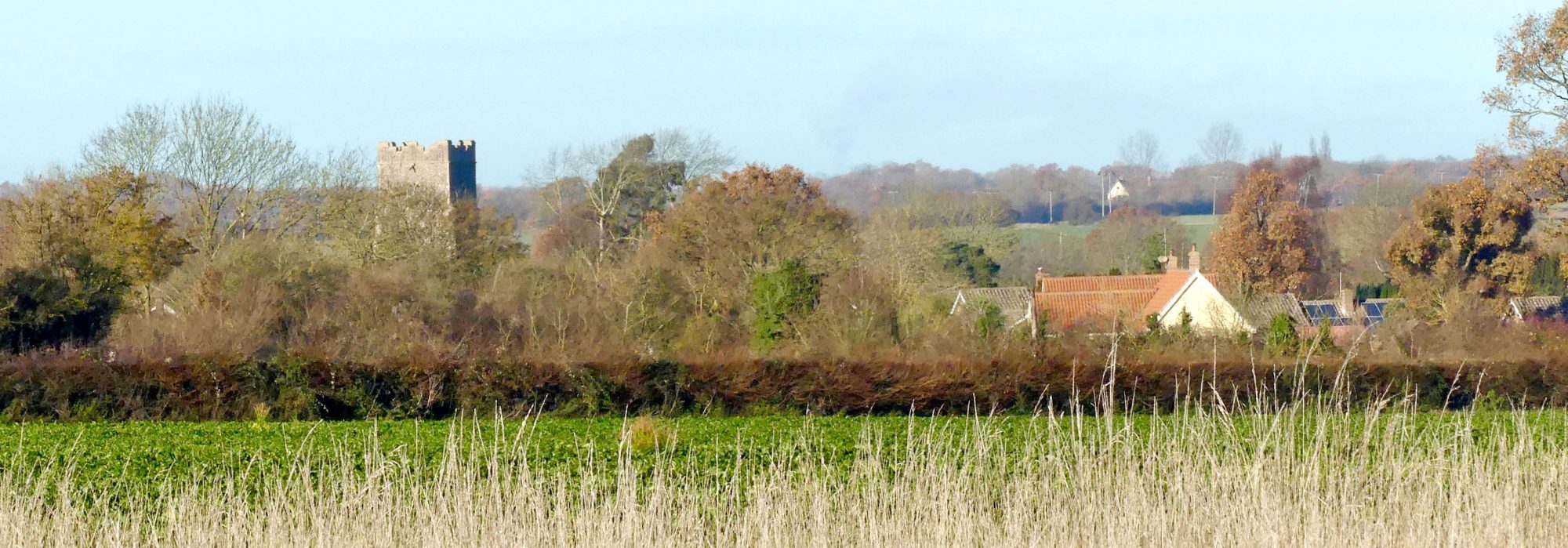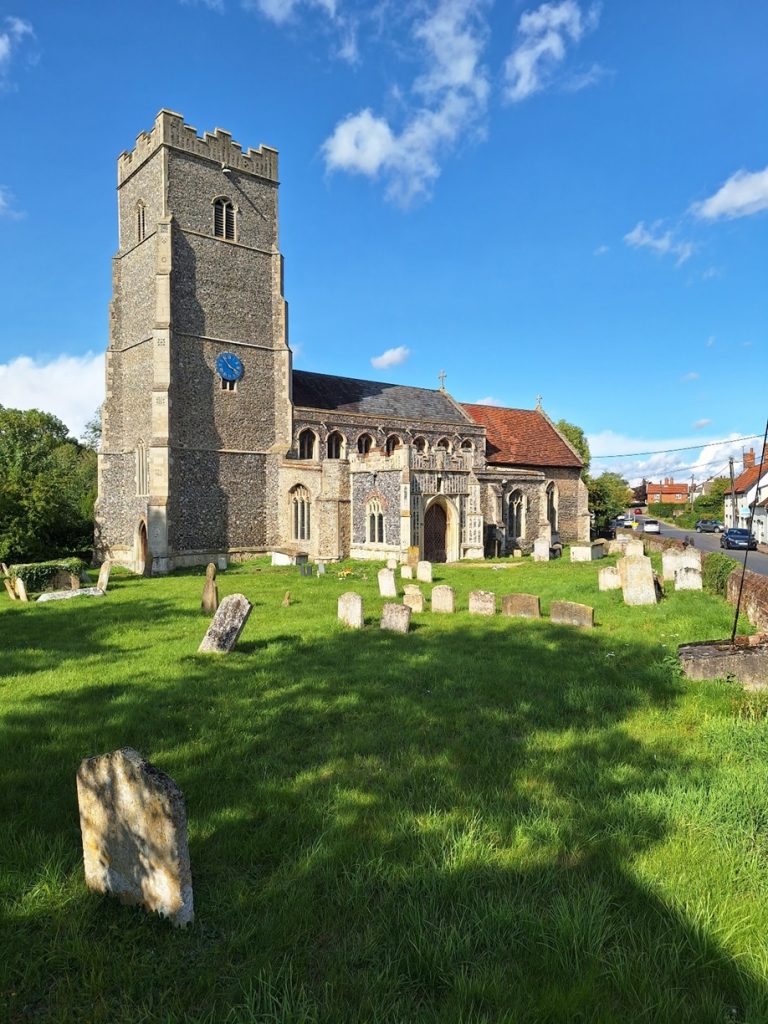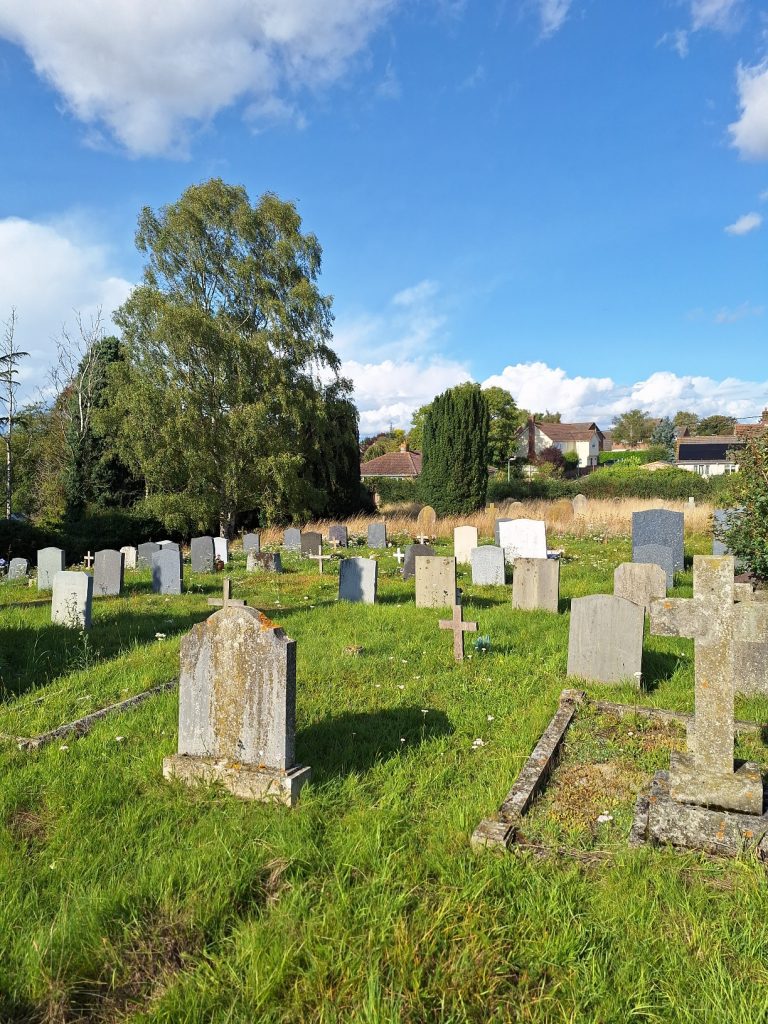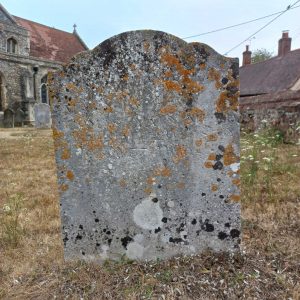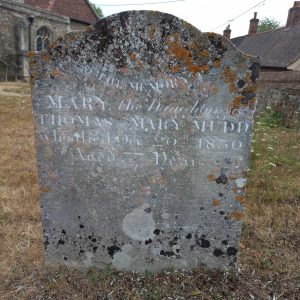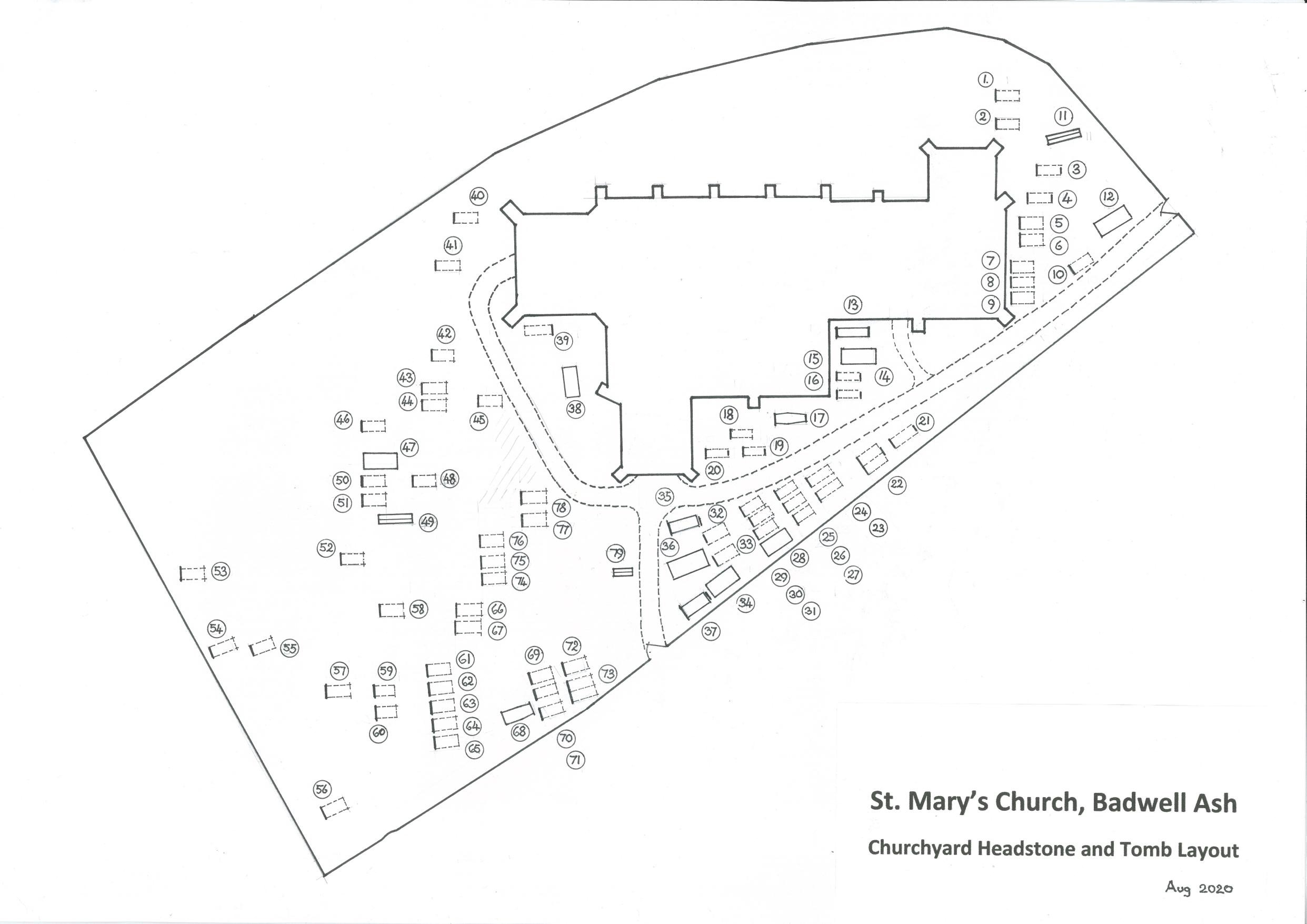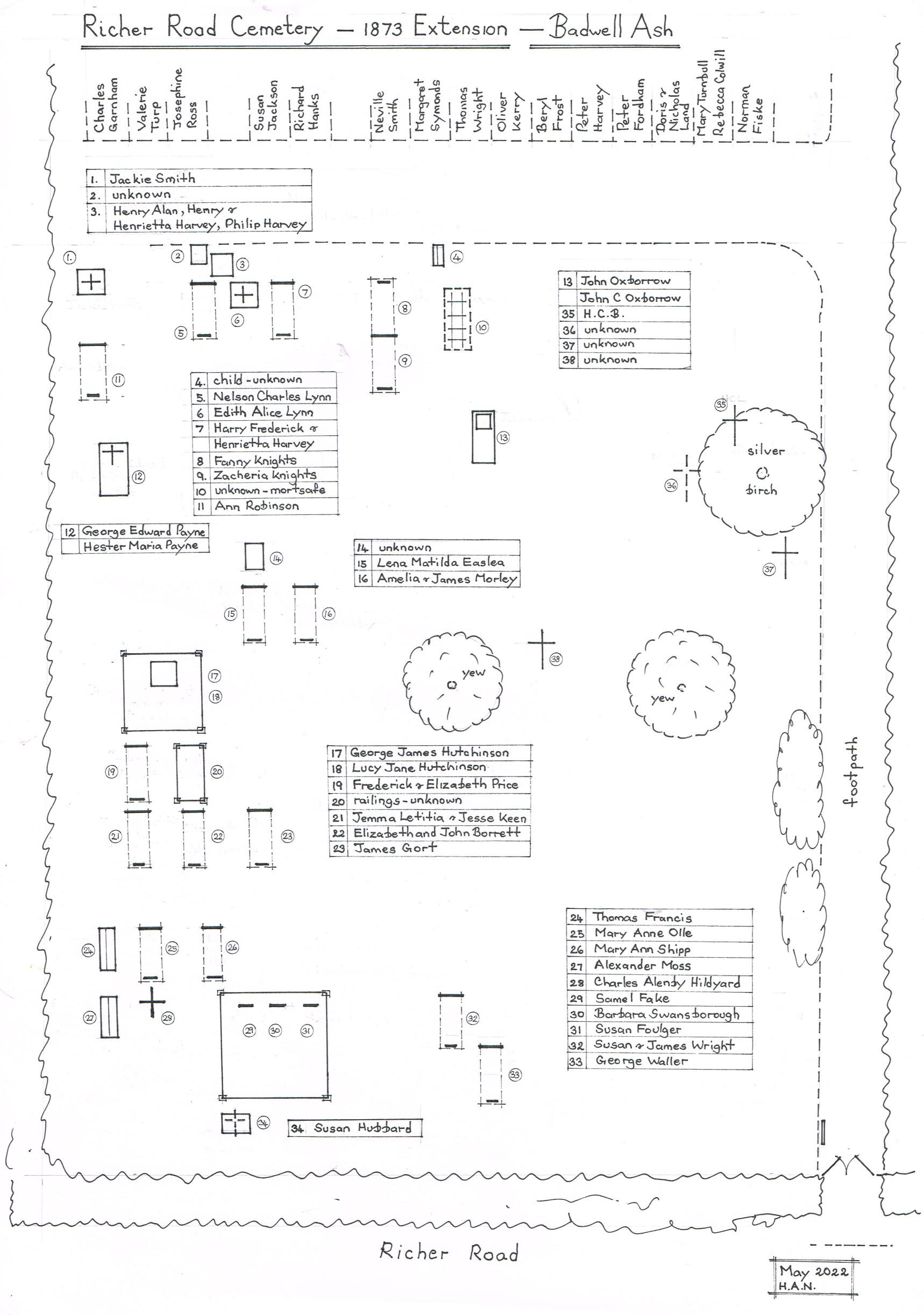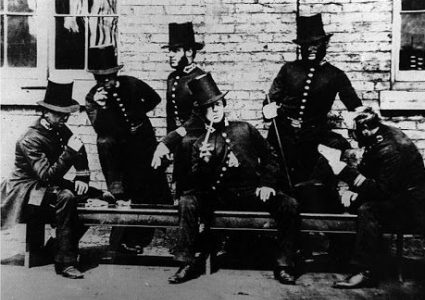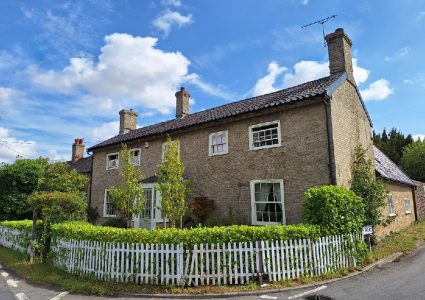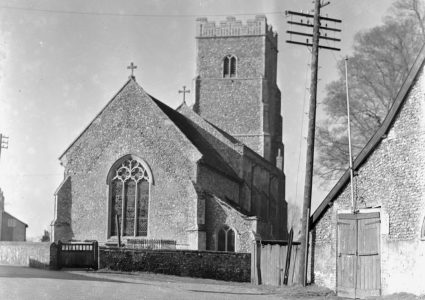No written grave records exist for the burials in either the Churchyard surrounding St. Mary’s Church or oldest part of The Churchyard Extension, dating from 1875, in Richer Road. Although lists of burials exist dating back to Elizabethan times, exactly where many of these people were buried has long been lost. We assume that between about 3,000 – 3,500 villagers have been buried in the Churchyard since a church was built on this site but there are no records of where most of these people were buried. The only evidence we have are the standing headstones.
On the formation of The Church of England in 1534 by Henry VIII, parishes were obliged to record burials. However, this obligation was not always adhered to so, when Queen Elizabeth I became Queen of England, she decreed in 1597 that all burial records must be kept in bound parish registers. Between 1559 to today, we know that there have been over 2,450 burials either in the Churchyard or the Richer Rd extension. The latter part of the Richer Rd Churchyard Extension, which was opened in 1915 and is used today, is well documented. However, the records for the lower part of the Richer Rd Churchyard Extension, adjacent to the road, which was opened in 1875 have been lost.
Research was carried out in the spring and summer of 2022 to try to ascertain who was buried in these graveyards and, more importantly, where their bodies lie using the only tangible evidence available, the headstones and tombs. Many families would have been too poor to have a headstone erected for their loved ones so, unfortunately, their whereabouts can never be established. However, there are 79 standing headstones and tombs in St. Mary’s churchyard and 39 in Richer Road. That is, of course, only a tiny percentage of all the burials but, there is no other way of establishing the precise location of the deceased other than these headstones and memorials.
The oldest headstone still standing in St. Mary’s Churchyard dates from 1660, some 360 years ago, the year when Charles II ascended to the throne after 11 years of Parliamentary rule. Unfortunately, over time, many of these memorials to the deceased have become severely weathered and cannot be read. It was therefore decided that it was becoming an urgent priority to record what exists now before many more become illegible.
The method to discover the text on the headstones where this was illegible was simple. Shaving foam was sprayed on to each headstone where the names could not be read and then, using a flat plastic or cardboard scraper so as not to damage the headstone, majority of the foam was removed which left the inscribed names clearly visible. The shaving foam does not damage the headstone and is washed off by the first rain shower.
Using this method, almost 100% of the standing headstones could be read and the results can be seen in the two schedules for St. Mary’s Churchyard and The Richer Road Churchyard Extension.
Badwell Ash History Society
November 2023
- Name Born - Died Location Plot No.
- Andrew, John jnr - - 1757 St. Mary's Church 53
- Avey, Robert 1806 - 1817 St. Mary's Church 52
- Baker, Sarah Ann 1826 - 1828 St. Mary's Church 79
- Blake, Dorothy - - 1855/33 St. Mary's Church 39
- Blake, John - - 1802 St. Mary's Church 74
- Blake, William - - 1818 St. Mary's Church 75
- Borrett, Elizabeth 1817 - 1883 Richer Road 23
- Borrett, John 1814 - 1891 Richer Road 23
- Brett, Thomas - 1791 St. Mary's Church 78
- Brett, William - - 1763 St. Mary's Church 61
- Brooks, James - - 1819 St. Mary's Church 8
- Brooks, John 1779 - 1829 St. Mary's Church 7
- Brooks, Robert - - 1809 St. Mary's Church 9
- Brown, Christopher 1777 - 1861 St. Mary's Church 57
- Brown, Mary 1742 - 1826 St. Mary's Church 59
- Bull, George Edward 1831 - 1871 St. Mary's Church 58
- Bull, Sarah 1800 - 1845 St. Mary's Church 58
- Chinnery, Mary 1835 - 1858 St. Mary's Church 45
- Coates, Diana Rose 1767 - 1831 St. Mary's Church 15
- Collins, Hannah 1799 - 1832 St. Mary's Church 43
- Cullum, Susannah 1785 - 1810 St. Mary's Church 66
- Cutchey, Bartholemew 1768 - 1831 St. Mary's Church 22
- Cutchey, John 1740 - 1800 St. Mary's Church 13
- Cutchey, John 1714 - 1783 St. Mary's Church 13
- Cutchey, Susan 1715 - 1772 St. Mary's Church 13
- Cutchey, Susan 1789 - 1868 St. Mary's Church 22
- Easlea, Lena Matilda 1862 - 1898 Richer Road 16
- Ellis, Elizabeth 1790 - 1854 St. Mary's Church 40
- Fake, Mary 1801 - 1821 St. Mary's Church 55
- Fake, Mary Ann 1799 - 1865 St. Mary's Church 54
- Fake, Samuel 1796 - 1867 St. Mary's Church 54
- Fake, Samuel 1839 - 1878 Richer Road 30
- Flowerdew, Esther - - 1705 St. Mary's Church 32
- Fordham, Herbert Clears 1900 - 1988 St. Mary's Church 80
- Foulger, Susan 1803 - 1879 Richer Road 32
- Francis, Sarah 1804 - 1837 St. Mary's Church 5
- Francis, Thomas Richer 1803 - 1880 Richer Road 25
- Frost, John 1663 - 1711 St. Mary's Church 18
- Garnham, Elizabeth 1654 - 1738 St. Mary's Church 23
- Garnham, Henry (Harry) - - 1775 St. Mary's Church 21
- Garnham, Mary - - - St. Mary's Church 21
- Garnham, Robert 1630 - 1705 St. Mary's Church 25
- Garnham, Robert (infant) - - - St. Mary's Church 24
- Garnham, Robert The Elder - - 1660 St. Mary's Church 27
- Garnham, Sarah 1652 - 1665 St. Mary's Church 26
- Garnham, Warren 1681 - 1775 St. Mary's Church 21
- Gort, James 1836 - 1890 Richer Road 24
- Harvey, Harry Frederick 1876 - 1890 Richer Road 8
- Harvey, Percy Alan 1884 - 1886 Richer Road 3
- Harvey, Philip Alfred 1884 - 1886 Richer Road 3
- Hildyard, Charles Alenby 1817 - 1876 Richer Road 29
- Hubbard, Emily 1785 - 1843 St. Mary's Church 56
- Hunt , Robert 1799 - 1851 St. Mary's Church 4
- Hutchinson, Lucy Jane 1863 - 1955 Richer Road 18
- Hutchinson, Revd George James 1856 - 1898 Richer Road 18
- Jackaman, Susannah 1823 - 1856 St. Mary's Church 48
- Jolly, Thomas 1755 - 1796 St. Mary's Church 77
- Keen, Jemima Letitia 1844 - 1880 Richer Road 22
- Keen, Jesse 1837 - 1893 Richer Road 22
- Kinsey, Mary 1807 - 1826 St. Mary's Church 51
- Kinsey, Simon 1780 - 1852 St. Mary's Church 49
- Kinsey, Susan 1781 - 1855 St. Mary's Church 49
- Knights, Francis (Fanny) 1822 - 1894 Richer Road 9
- Knights, Zaccarhia 1817 - 1903 Richer Road 10
- Leggatt, Ann 1780 - 1862 St. Mary's Church 16
- Lummas, Henry Cecil 1914 - 1915 Richer Road 36
- Lynn, Edith Alice 1890 - 1891 Richer Road 7
- Lynn, Harriet Elizabeth 1852 - 1900 Richer Road 6
- Lynn, Nelson Charles 1877 - 1893 Richer Road 5
- Mayes, Robert - - 1735 St. Mary's Church 46
- Mayhew, George 1795 - 1864 St. Mary's Church 12
- Meadows, Susan - - 1808 St. Mary's Church 17
- Meadows, Susan - - 1816 St. Mary's Church 17
- Meadows, Thomas 1797 - 1876 St. Mary's Church 17
- Morley, Amelia 1830 - 1900 Richer Road 17
- Morley, Anna Maria 1860 - 1861 St. Mary's Church 2
- Morley, James 1833 - 1905 Richer Road 17
- Morley, Maria 1835 - 1860 St. Mary's Church 2
- Moss, Alexander 1767 - 1839 St. Mary's Church 37
- Moss, Alexander 1793 - 1875 Richer Road 28
- Moss, Charles 1757 - 1801 St. Mary's Church 62
- Moss, James 1766 - 1841 St. Mary's Church 35
- Moss, Mary 1762 - 1845 St. Mary's Church 35
- Moss, Mary - - 1802 St. Mary's Church 37
- Moss, Mary - - 177? St. Mary's Church 63
- Moss, Mary 1818 - 1875 Richer Road 28
- Moss, Robert 1754 - 1802 St. Mary's Church 60
- Moss, William jnr - - 1782 St. Mary's Church 65
- Moss, William snr 1748 - 1781 St. Mary's Church 64
- Mudd, Ann 1805 - 1822 St. Mary's Church 71
- Mudd, Elizabeth 1796 - 1824 St. Mary's Church 70
- Mudd, James 1794 - 1841 St. Mary's Church 68
- Mudd, Maria 1802 - 1868 St. Mary's Church 68
- Mudd, Mary 1769 - 1831 St. Mary's Church 73
- Mudd, Mary (1830) 1796 - 1830 St. Mary's Church 72
- Mudd, Sarah 1805 - 1826 St. Mary's Church 69
- Mudd, Thomas 1764 - 1845 St. Mary's Church 73
- Nunn, Elizabeth - - 1817 St. Mary's Church 10
- Nunn, Elizabeth 1715 - 1770 St. Mary's Church 34
- Nunn, Francis - - 1791 St. Mary's Church 41
- Nunn, George 1708 - 1710 St. Mary's Church 29
- Nunn, Joshua 1709 - 1710 St. Mary's Church 30
- Nunn, Martha 1717 - 1721 St. Mary's Church 31
- Nunn, Martin 1668 - 1724 St. Mary's Church 28
- Nunn, Mary 1678 - 1756 St. Mary's Church 28
- Nunn, Susannah 1719 - 1731 St. Mary's Church 28
- Nunn, William 1706 - 1746 St. Mary's Church 28
- Olle, Mary Ann 1818 - 1881 Richer Road 26
- Oxborrow, John George 1844 - 1913 Richer Road 14
- Parker, Agnes 1873 - 1875 Richer Road 35
- Parker, Anna Maria 1810 - 1824 St. Mary's Church 38
- Parker, Elizabeth Rose 1771 - 1848 St. Mary's Church 38
- Parker, Emma 1815 - 1854 St. Mary's Church 14
- Parker, Frank 1875 - 1875 Richer Road 35
- Parker, Philip 1769 - 1842 St. Mary's Church 38
- Parker, Philip jnr 1793 - 1812 St. Mary's Church 38
- Parker, Samuel 1795 - 1854 St. Mary's Church 14
- Parker, Samuel Philip 1840 - 1899 St. Mary's Church 14
- Parker, Sarah 1810 - 1821 St. Mary's Church 38
- Parker, Susannah 1840 - 1875 Richer Road 35
- Parker, William 1808 - 1815 St. Mary's Church 38
- Parr, Edward 1800 - 1861 St. Mary's Church 11
- Parr, Sarah Ann - - 1873 St. Mary's Church 11
- Pattle, Daniel Moss 1765 - 1846 St. Mary's Church 36
- Pattle, Mary 1745 - 1786 St. Mary's Church 36
- Payne, George Edward 1823 - 1912 Richer Road 13
- Payne, Hester Maria 1826 - 1916 Richer Road 13
- Price, Elizabeth 1830 - 1908 Richer Road 20
- Price, Frederick 1830 - 1894 Richer Road 20
- Quantrill, Thomas 1703 - 1771 St. Mary's Church 76
- Richer, Sarah 1769 - 1847 St. Mary's Church 6
- Richer, Thomas 1767 - 1842 St. Mary's Church 6
- Robinson, Ann 1817 - 1901 Richer Road 12
- Rose, Diana 1746 - 1785 St. Mary's Church 14
- Rose, William 1741 - 1808 St. Mary's Church 14
- Runnicus, Henry 1755 - 1830 St. Mary's Church 44
- Sadler, Joseph - - 1837/57 St. Mary's Church 67
- Shipp, James 1800 - 1865 St. Mary's Church 3
- Shipp, James (1862) 1827 - 1862 St. Mary's Church 1
- Shipp, Mary Ann 1813 - 1883 Richer Road 27
- Smith, Jackie 1907 - 1912 Richer Road 1
- Spark, James - - 1809 St. Mary's Church 17
- Spark, Susan - - 1807 St. Mary's Church 17
- Swansborough, Barbara 1842 - 1879 Richer Road 31
- Thrower, Elizabeth 1843 - 1843 St. Mary's Church 20
- Thrower, James 1808 - 1843 St. Mary's Church 20
- Thrower, Louisa Jane 1817 - 1838 St. Mary's Church 33
- Thrower, Samuel 1777 - 1860 St. Mary's Church 33
- Thrower, Sara 1779 - 1862 St. Mary's Church 33
- Thrower, William 1811 - 1854 St. Mary's Church 19
- Unknown, - St. Mary's Church 42
- Unknown, - St. Mary's Church 47
- Unknown, - St. Mary's Church 50
- Unknown, Broken Wooden Cross - Richer Road 37
- Unknown, Child Burial - Richer Road 2
- Unknown, Child Burial - Richer Road 4
- Unknown, Child Burial - Richer Road 15
- Unknown, Fenced Grave - Richer Road 21
- Unknown, Mortsafe - Richer Road 11
- Unknown, Wooden Cross - Richer Road 38
- Unknown, Wooden Cross - Richer Road 39
- Waller, George 1804 - 1878 Richer Road 34
- Wright, James 1806 - 1891 Richer Road 33
- Wright, Susan 1815 - 1880 Richer Road 33
